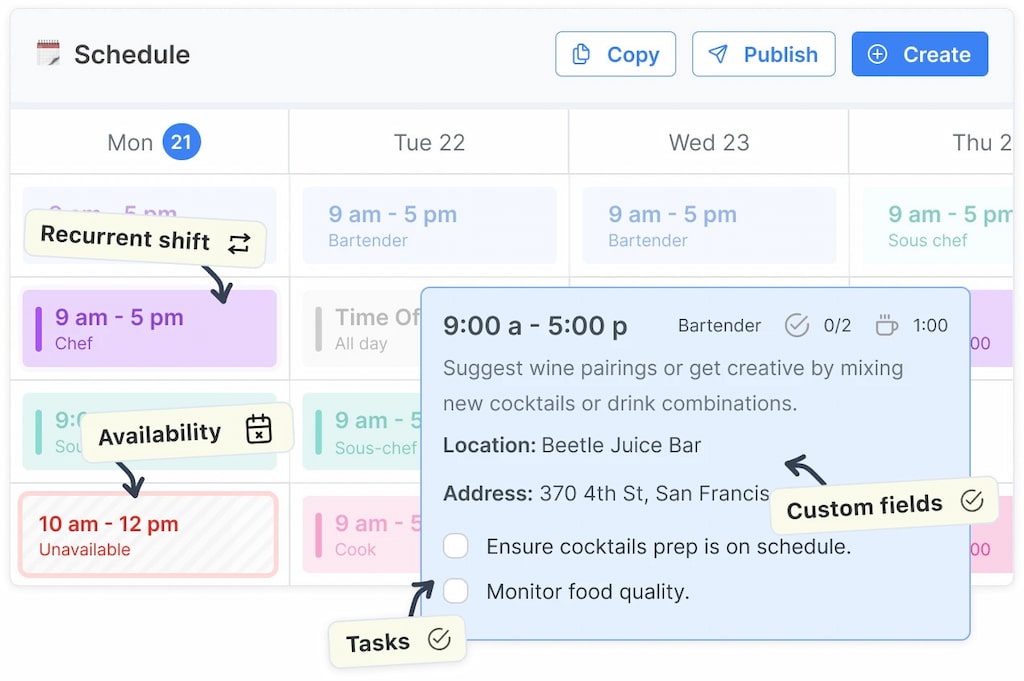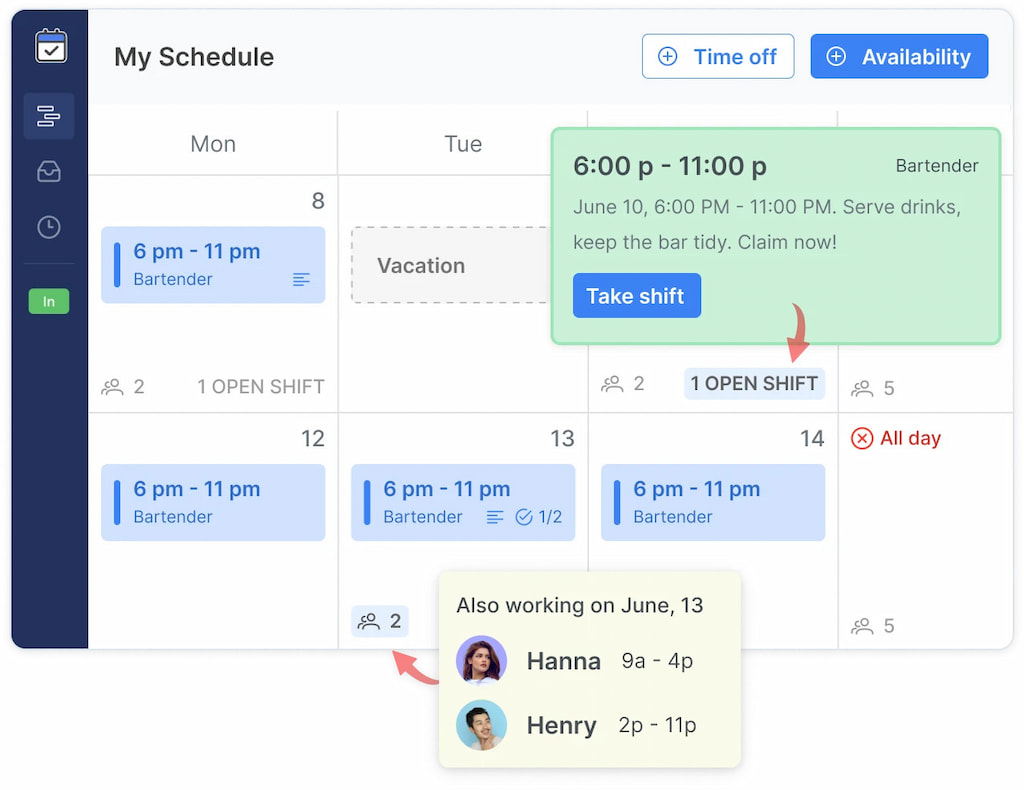It’s morning on site #12, but your crew is late because the previous job overran by two hours. Supplies are en route, subcontractors are delayed, and the updated plan you printed last night is already obsolete. Welcome to the world of construction scheduling — dynamic, messy, and always changing.
Behind every successful build lies a well-maintained schedule. But in 2025’s fast-paced environment, “schedule” must mean adaptive, collaborative, and always visible. In this guide, you’ll learn what construction scheduling software offers, what to prioritize, and how Shifts by Everhour, a construction scheduling solution, can bring clarity to scheduling + time tracking.
What Is Construction Scheduling Software?
🏗️ Construction scheduling software is a specialized tool that helps plan, organize, and monitor project timelines — assigning tasks, coordinating resources, managing dependencies, and reacting to changes in real time.
🧱 Unlike generic project management tools, construction schedulers are built for the field. They handle subcontractors, shifting timelines, site logistics, permit constraints, and labor or equipment availability — effectively bridging the gap between the office and the job site.
☁️ In 2025, a robust scheduler must be cloud-based, mobile-first, and collaborative, seamlessly integrated with time tracking and reporting systems. Oracle highlights mobile accessibility as a key factor for real-time updates and field adjustments.
Key Features & Use Cases That Make a Difference
🗂️ Gantt & dependency planning
The core of any construction scheduling tool lies in dependency logic. Tasks like plumbing can’t begin until framing is done, and deliveries depend on site prep. The software automates these links and recalculates timelines as changes occur.
👷 Resource & crew allocation
Assign crews, equipment, and materials to each task. The system alerts you to over-allocation or conflicts so you can rebalance before issues arise.
📡 Real-time updates from the field
Managers and crews see updates instantly. Subcontractors can report delays, share photos, and adjust timelines on the go — as seen in Workyard’s live updates feature.
📱 Mobile access & offline support
Your team needs to view schedules, track progress, and upload images directly from the site. Without mobile access, scheduling stays stuck in the office.
⏱️ Integrated time tracking & scheduled vs actual
A combined schedule + time tracking setup helps catch inconsistencies, supports payroll, and flags scope creep. Plaky underscores time tracking as a must-have.
🔔 Communication & notifications
Automated reminders, delay alerts, and in-task comments keep all teams aligned — minimizing untracked messages and miscommunication.
🧩 Template & project cloning
Save successful project structures as templates for repeat builds. Buildxact, for instance, enables templates directly tied to estimates.
📊 Reporting & analytics
Real-time dashboards show progress vs baseline, delay causes, and resource utilization so you can steer instead of react. Deltek highlights collaboration and visibility as key strengths.
🔗 Integration with other systems
Connect scheduling with accounting, procurement, BIM, or ERP tools. The best platforms fit seamlessly into your existing workflow — as ContractorForeman demonstrates.
Top Construction Scheduling Software in 2025
| Tool | Key Features | Pricing/Plan | Ideal For |
| Shifts by Everhour | Drag-and-drop scheduling; open shifts & swaps; built-in time tracking; real-time updates; mobile access | Free & paid plans | Teams wanting schedule + time data tightly coupled |
| Procore (Scheduling module) | Gantt, lookahead, filtering by trade; integration with logs & tasks | Enterprise licensing | Mid-to-large contractors wanting all-in-one project management |
| Buildertrend | Scheduling, change orders, client portal, mobile app | Paid plans | Home builders, remodelers needing schedule + client visibility |
| Fieldwire | Task management, schedule import, duplication, collaborative updates | Free & paid tiers | Field-oriented construction crews managing day to day tasks |
| ALICE | AI-driven schedule optimization; scenario modeling; resource balancing | Enterprise pricing | Large, complex builds needing schedule recovery & optimization |
| Touchplan | Daily planning, pull scheduling, collaboration, analytics | Paid plans | GCs and specialty contractors running lean, adaptive builds |
| Outbuild | Integrated lookahead; Procore sync; schedule updates; field interface | Paid plans | Teams wanting a modern scheduling layer above Procore |
| Deltek (vision/Acumen) | Resource leveling, CPM, schedule analytics | Enterprise licensing | Large firms needing deep schedule control and reporting |
| Foundation Scheduling Module | Auto-create schedules from jobs; drag-and-drop; conflict alerts | Licensed module | Contractors already on the Foundation accounting platform |
Tool highlights & use cases
- Shifts by Everhour: Ideal for teams that want scheduling and time capture in one system.
- Procore: Best for full-suite construction operations where scheduling is just one module among many.
- Buildertrend: Popular for small to mid-scale builders with client-facing features.
- Fieldwire: Lightweight, field-first schedule and task manager.
- ALICE: Uses AI to model and recover schedules in complex, constraint-driven environments.
- Touchplan: Excellent for lean daily planning and collaboration.
- Outbuild: Focuses on schedule layering, smart sync, and version control.
- Deltek: Deep scheduling capabilities with enterprise-level control.
- Foundation Scheduling: Best for firms already using the Foundation suite — logic flows from their job cost engine.
How Shifts by Everhour Elevates Scheduling
When scheduling is disconnected from time capture, you end up reconciling hours, chasing discrepancies, and losing profitability. Shifts by Everhour bridges that gap, letting you manage schedules and measure actual performance in one flow. Here’s how it contributes:
- Unified view: See staffing plans alongside recorded hours.

- Conflict prevention: Detect overlapping assignments or over-allocations as you build rosters.
- Open shift pickup & swaps: Empower crews to adjust within guardrails, reducing admin churn.

- Scheduled vs actual comparisons: Spot tasks that consistently take longer than estimated.
- Notifications & mobile updates: Field personnel stay synced on changes instantly.
This synergy ensures your schedule is not just a plan — it’s a living tool that drives accountability, adapts, and provides feedback.
Best Practices: From Blueprint to Reality
- 🏁 Start with a mandatory kickoff schedule session – Ensure all discipline leads align on logic, float times, and constraints.
- 🛡️ Protect your float – Don’t schedule every minute; buffer time absorbs delays.
- 📊 Review delays weekly – Use analytics to identify recurring blockers.
- ⏳ Limit changes after threshold date – Freeze major shifts 48 hours ahead unless critical.
- 🗂️ Use schedule versioning – Keep old versions for audit trails and let your team see “what changed.”
- 🔄 Continually update baselines – Re-baseline remaining timelines as tasks finish.
- 📱 Train field users – A schedule only works if crews use it in the field; mobile training is essential.
FAQ: Construction Scheduling Software
Do I need both scheduling and time tracking?
Yes — having both in one system removes reconciliation errors and surfaces real gaps between plan vs reality.
What’s the best mobile experience?
Apps like Fieldwire, Buildertrend, and Shifts by Everhour offer robust mobile support; more complex tools like Procore are improving but often need connectivity.
Is AI scheduling worth it?
For large, constrained, multi-phase projects, AI planning helps recover schedule drift. For smaller jobs, classic CPM tools may be sufficient.
How often should I update the schedule?
At least weekly, or whenever a critical task changes. Most leading tools recalculate automatically.
Can these tools integrate with accounting?
Yes — many include APIs or built-in connectors (e.g. with QuickBooks, Foundation, Procore, SAP).
Final Thoughts
Construction schedules are not static: they breathe, shift, and must adapt. The software you choose should accommodate change — not resist it.
The right scheduling tool lets you build smarter initial plans, respond fast when things go wrong, and learn continuously from project data. Tools like Shifts by Everhour shine here, giving you scheduling + time insight in one source of truth.
If managing delays, manual rework, and miscommunications is your day job, it might be time to let your schedule work for you. Start with one project, roll out scheduling + tracking, and let data carry your decisions forward.

